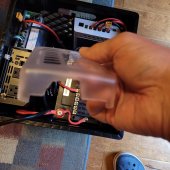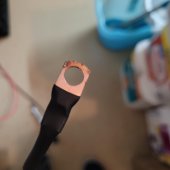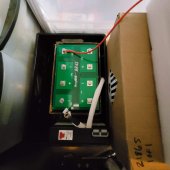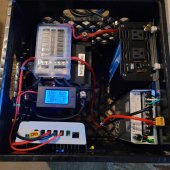BobbyMac
New Member
- Joined
- Jun 1, 2021
- Messages
- 18
I have competed my first DIY project and wanted to share a few mistakes and a things I would have done differently but nothing major. I started with the base recommendations and advice that Will gave with the Milk Crate and 2.0 tubes online. I purchased almost all the same components but it didn't start that way.
1st mistake: I tried to save a few bucks on a cheaper inverter. So I poke around on Amazon and see this 600W pure inverter and I would save about 30.00. It comes from Amazon and instantly I knew I made a mistake. It felt light and had simple sheet metal with no cooling fins on the housing and despite have a n average of 4 stars, it was either 5 star or 2 star rating. A co-worker has literally designed power systems for the Navy said, "if an inverter doesn't have heat dissipation built into the housing, don't get it." Returned and followed Will's advice and got the 600W Giandel. Future problem 1 avoided.
2nd mistake: I watched Will place the fuse box too close to the side of the crate which would have placed connections close to the side. I learned from his mistake so I made sure to have enough room. What was the mistake? I placed the box too close to the positive connector to be able to exit the clear fuse box cover with out hitting the crate. This was an easy fix in that I just needed to cut a little bit larger opening so the wire could exit and an angle. I would have had enough room to move it a little bit so that the "modification" to the top could have been less dramatic.

3rd mistake: This isn't really a mistake but it is a component choice. The Drok power supply is NOT UL listed. I wasn't going to be plugging this in a forgetting about it so that isn't a huge deal. I will use it to charge but for a limited amount of time and always somewhat "attended". What I should have gotten is this, Mean Well. It doesn't have the external LED but a simple meter check and I could have hit the 14.1 setting. It is UL listed and only .49 more than the Drok. My co-worker has used these for years in a set it and leave it on 24x7 for years type of thing.
4th mistake: OK, I didn't listen to Will but the EPEver MPPT software is the traditional COMs port connection and the USB/RS-485 to RJ45 cable works but is worthless because my WIN10 pro OS doesn't recognize it as a RS-485 protocol connection (no check box in the port settings). SO I went back and bought the MT50 remote to program the controller.
5th mistake: I thought I could "charge" a separate battery (BatteryEvo DIY 150AH) with the Drok. BIG MISTAKE! I received the battery, assembled and flip the switch to the BMS, not worky. HMMMM, let me charge this thing with the Drok. DO NOT CHARGE A COMPLETELY DISCHARGE BATTERY WITH A PSU!!!!! I had hot arcs and scary pops but luckily it only sacrificed a 15A fuse on the fuse box.


6th and last mistake: I used off brand 2xsided tape. 3M is the gold standard and is only 1.00 MORE
Lesson Learned #1! If you are going to do DIY projects with batteries for Ali or Evo, buy GOOD charger. When they arrive drained you can charge them. This is where I spent more of "my own money" (imitation is the highest form of flattery) and bought a Victron charger.
I added a cheap Shunt and Meter to complete the build. This was SOOOO fulfilling to complete and has really peaked my DIY interest. In parts alone, I have about $659.00 into the parts minus the 10g wire "because I have a ton of it" (more imitation) and tools.
Here is what the completed crate looks like..... Next steps are size the array for the the 30A MPPT. I am thinking of 2 190W 12v panels in series for 24v 280W. I'll connect it with 30ft of 10G to the XT60 connector on the MPPT. What am I looking for is suggestions on the array and "other" thoughts. I would like to keep it to 2 panels in series for 24v but want to minimize charge time. The big 300+ watt panels seem to be too large to easily store and pull out on an ad-hoc basis. Thoughts?

1st mistake: I tried to save a few bucks on a cheaper inverter. So I poke around on Amazon and see this 600W pure inverter and I would save about 30.00. It comes from Amazon and instantly I knew I made a mistake. It felt light and had simple sheet metal with no cooling fins on the housing and despite have a n average of 4 stars, it was either 5 star or 2 star rating. A co-worker has literally designed power systems for the Navy said, "if an inverter doesn't have heat dissipation built into the housing, don't get it." Returned and followed Will's advice and got the 600W Giandel. Future problem 1 avoided.
2nd mistake: I watched Will place the fuse box too close to the side of the crate which would have placed connections close to the side. I learned from his mistake so I made sure to have enough room. What was the mistake? I placed the box too close to the positive connector to be able to exit the clear fuse box cover with out hitting the crate. This was an easy fix in that I just needed to cut a little bit larger opening so the wire could exit and an angle. I would have had enough room to move it a little bit so that the "modification" to the top could have been less dramatic.

3rd mistake: This isn't really a mistake but it is a component choice. The Drok power supply is NOT UL listed. I wasn't going to be plugging this in a forgetting about it so that isn't a huge deal. I will use it to charge but for a limited amount of time and always somewhat "attended". What I should have gotten is this, Mean Well. It doesn't have the external LED but a simple meter check and I could have hit the 14.1 setting. It is UL listed and only .49 more than the Drok. My co-worker has used these for years in a set it and leave it on 24x7 for years type of thing.
4th mistake: OK, I didn't listen to Will but the EPEver MPPT software is the traditional COMs port connection and the USB/RS-485 to RJ45 cable works but is worthless because my WIN10 pro OS doesn't recognize it as a RS-485 protocol connection (no check box in the port settings). SO I went back and bought the MT50 remote to program the controller.
5th mistake: I thought I could "charge" a separate battery (BatteryEvo DIY 150AH) with the Drok. BIG MISTAKE! I received the battery, assembled and flip the switch to the BMS, not worky. HMMMM, let me charge this thing with the Drok. DO NOT CHARGE A COMPLETELY DISCHARGE BATTERY WITH A PSU!!!!! I had hot arcs and scary pops but luckily it only sacrificed a 15A fuse on the fuse box.


6th and last mistake: I used off brand 2xsided tape. 3M is the gold standard and is only 1.00 MORE
Lesson Learned #1! If you are going to do DIY projects with batteries for Ali or Evo, buy GOOD charger. When they arrive drained you can charge them. This is where I spent more of "my own money" (imitation is the highest form of flattery) and bought a Victron charger.
I added a cheap Shunt and Meter to complete the build. This was SOOOO fulfilling to complete and has really peaked my DIY interest. In parts alone, I have about $659.00 into the parts minus the 10g wire "because I have a ton of it" (more imitation) and tools.
Here is what the completed crate looks like..... Next steps are size the array for the the 30A MPPT. I am thinking of 2 190W 12v panels in series for 24v 280W. I'll connect it with 30ft of 10G to the XT60 connector on the MPPT. What am I looking for is suggestions on the array and "other" thoughts. I would like to keep it to 2 panels in series for 24v but want to minimize charge time. The big 300+ watt panels seem to be too large to easily store and pull out on an ad-hoc basis. Thoughts?

Last edited:


